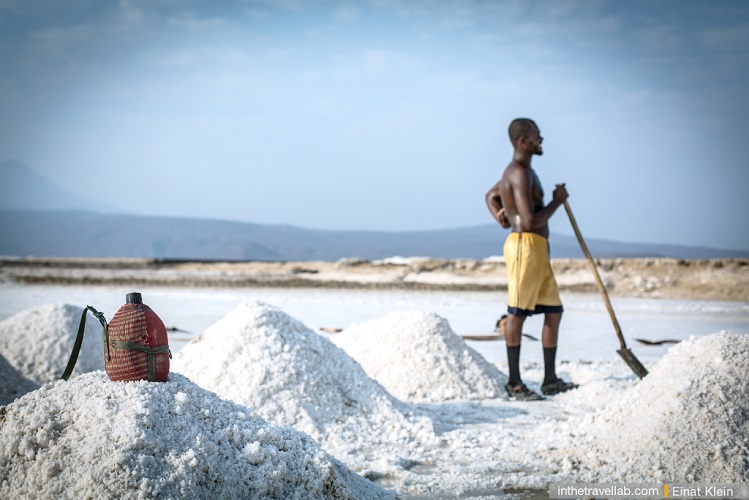
Ethiopia has a long-standing tradition of salt production and trade. Salt holds immense significance in the Ethiopian context, encompassing historical, cultural, and economic dimensions. Its production, trade, and utilization have shaped the country’s identity and contributed to its vibrant heritage. As Ethiopia continues to evolve and embrace modernization, the salt industry remains a fascinating aspect of the nation’s past, present, and future.
The country’s unique geographical features, such as the Danakil Depression and the Afar region, have made Ethiopia a prominent source of salt. The salt industry has played a pivotal role in the country’s history, facilitating trade, cultural exchange, and economic development. It is also a prominent source of salt, attracting both domestic and international attention.
Salt has been a vital commodity in Ethiopia, it has been used not only to enhance the taste of food but also for food preservation as well as for traditional healing practices. The salt trade routes in Ethiopia have facilitated cultural exchange and commerce, contributing to the country’s rich heritage.
The Ethiopian salt industry has not only served domestic needs but has also been an important source of revenue through trade. Salt caravans, comprising long lines of camels and donkeys, have historically transported salt from the Danakil Depression to various regions of Ethiopia and beyond. These caravans have played a crucial role in connecting different parts of the country and facilitating cultural exchange.
According to the Ministry of Mining data, the manufacturing of salt and factory processing have provided about 20,000 employment opportunities.
Furthermore, the tourism industry has also been attracted to the unique salt formations and landscapes of Ethiopia. Travelers and adventurers from around the world visit the Danakil Depression to witness the captivating salt flats, colorful mineral deposits, and the active Ertale volcano.
Lack of resources for raw and washed salt for salt processors, unequal production costs and selling prices, illegal salt trade or smuggling, entry of foreign salt production into the nation, and the stagnation of manufacturing industries that use salt as an input are major hindrances. In addition, the increase in salt production in the country has become a big challenge for society, not only in the social but also in the business sectors.
Operations Manager at Bahirdar Tannery, Biruk Haile, stated that it is essential to use sufficient salt resources to preserve leather as well as boost output and productivity in order to make high-quality goods. Due to the fact that salt is so expensive, he stated, it is impossible to maintain the leather properly, which has a detrimental effect on output and product quality.
He explained that the high cost of salt makes it challenging to maintain the leather properly, which has a detrimental effect on output and product quality.
Commercial Department with Mojo (Kolba) Tannery’s, Melaku Wirtu, said on his part that the firm is not operating at full capacity as tanneries are undergoing scarce supply of salt. The consequent difficulty for their task, he claimed, is the high price of salt. As to him, traders surcharge up to 50% more than the real price.
He noted that the manufacturing industry needs 250 to 300 quintals of salt every month, but it is difficult to locate what is required, so that they purchase the majority of it from traders. He also claimed that the sector’s export business has severely declined.
In the same way, the shortage of salt supply and price inflation are the main reasons given for the factory’s inability to operate at full capacity, according to Abebe Teklu, General Manager of Ethio Leather Industry. He further stated that we use up to 1,200 Tons of salt annually. However, as to him, supplying it on time is challenging.
State Minister of Mining, Million Mathewos, on his part, stated that the increase in the price of salt in the market is a problem of supply and distribution rather than shortage of production.
He mentioned that More than 37 million quintals of salt have been produced and stored in production areas. However, he also said that due to the nation’s distribution issues, there is a shortage of supplies and the cost has increased. Additionally, there is little competition in the market for the supply of generated salt, which can only be purchased by a small number of investors, he added.
The Ethiopian government’s efforts to modernize the salt industry have aimed to improve production efficiency and increase revenue. Introducing mechanized methods, such as solar salt production, has the potential to enhance productivity, improve the livelihoods of salt workers, and expand opportunities for export to international markets. These advancements, while necessary for economic growth, must be balanced with the preservation of traditional practices and the protection of the cultural heritage associated with salt production.
Owner and managers of tanneries underlined that all concerned parts and private investors control the issues of leather factories. Moreover, the issue with salt production needs to be resolved as quickly as possible to implement. In addition, they suggested that the government provides remedies for various hindrances to the manufacture of leather.
According to Million, there are issues with the process of washing and delivering crude salt to processers and other companies that use salt as an input. He remarked that in order to address these issues. By increasing the monthly salt limit for table, tanneries, and companies working in various sectors that use salt as a resource from 572,800 to 700,152.79, he said that efforts are underway to address the issue of salt resource availability.
Additionally, he said that a nation could mitigate salt shortages by improving salt productivity, increasing salt production equipment, and lowering salt prices. Also, the Ministry works closely with the regional governance, the Ministry of Trade and Regional Integration, and all other parties involved, including commercial organizations.
The salt industry in Ethiopia also holds significant potential for tourism. The captivating landscapes of the Danakil Depression, with its surreal salt flats and vibrant mineral deposits, attract adventurers and travelers from around the world. By promoting sustainable tourism practices, Ethiopia can leverage its salt production sites as unique attractions, benefiting both local communities and the national economy.
As Ethiopia continues to evolve and embrace modernization, it is crucial to strike a balance between innovation and the preservation of cultural customs. The salt industry serves as a reminder of the country’s rich history and the resilience of its people. By nurturing this heritage and embracing sustainable practices, Ethiopia can ensure that salt production remains a vital part of its cultural identity and an engine for economic growth well into the future.
BY FIKADU BELAY
The Ethiopian Herald August 13/2023





